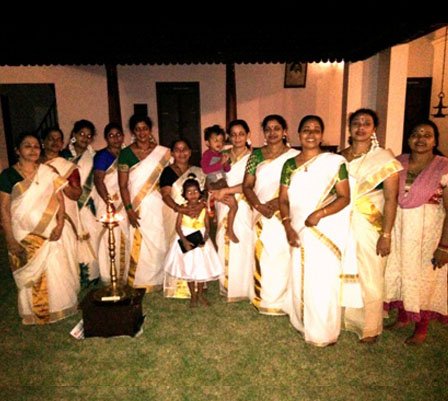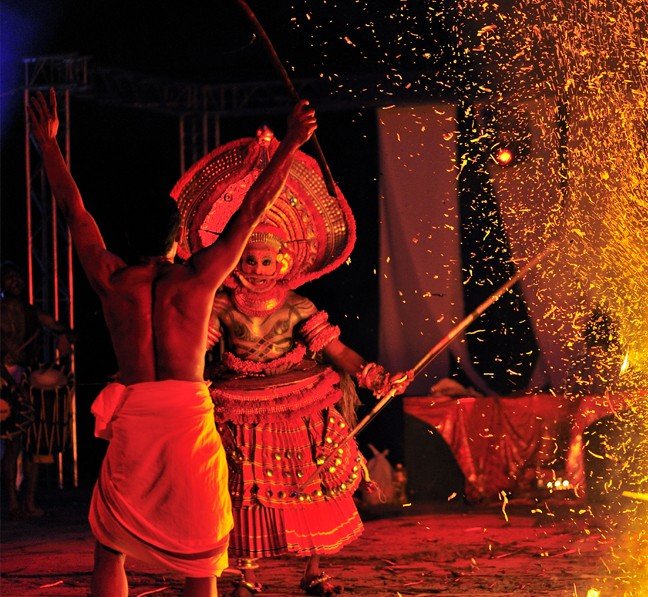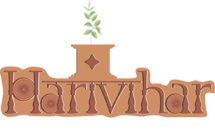
Arts and Life style
Apart from being a center of excellence in Ayurveda and yoga, Harivihar also does its bit in promoting traditional art-forms of Kerala which are facing an existential crisis.We write about them in our blogs and articles so that they get more exposure ,we help them in getting clients and we also conduct programmes inhouse, whenever possible. Please read below the various arts and crafts which you would find at Harivihar or in its vicinity. You can find more details in the blog section of our website.

Pulluvan pattu
Pulluvan pattu is a mystical art form once prevalent in many parts of Kerala. Pulluvan pattu is basically a form of snake worship done either in temples or houses. The pulluvan plays the veena made of bamboo and metal strings and sings the song while the pulluvathy accompanies along with the kutam, usually made of earthen ware and calf skin. Now, a dying art form, with the new generation showing little or no interest, Pulluvan pattu needs to be revived and revered for the future generations. Harivihar heritage homestead has started doing its little bit for the preservation of this dying art.Each month, during the day of Ayilyam (which is the day of snakes according to the Malayalam calendar), Harivihar conducts pulluvan pattu in its premises.
Mr Sivan and Remani,an octogenarian couple staying in the outskirts of Calicut, come to Harivihar to perform the Pulluvan pattu on the Ayilyam day of each month. (see the event calendar in our blog section).

Thiruvathirakali
Thiruvathirakali is a group dance performed by the ladies on the auspicious day of Thiruvathira, the birth day of Lord Shiva, in the Malayalam month of Dhanu(December-January). The purpose of the dance is to attain everlasting marital bliss and for the longevity of the spouse. The dance celebrates female energy (shakthi) which brought back to life Kamadeva from the wrath of Lord Shiva. The dance is performed around a lit lamp with the ladies making slow sinuous movements along with clapping their hands and singing ,giving it an amorous aura. Harivihar heritage homestead is committed to preserving the traditional arts of Kerala and we have a team of dancers from the neighbourhood who practice Thiruvathira Kali in our gardens, on the Thiruvathira day. Led by Ms Beena, the group consists of Ms Vinitha Kumari, Ms Mini, Ms Preethi, Ms Remani, Ms Komalam and Ms Rejitha.

Kalari
A short walk from Harivihar is the C.V.N Kalari at East hill. Kalari payat is the ancient physical, cultural and military art of Kerala, primarily developed many centuries ago for self defense. It gives the practitioner of the art perfect control over his body balance, flexibility, stamina and speed of movements. At C.V.N Kalari, East hill, watch the master train his students in unarmed and armed combat.Classes morning 5.30 to 8 a.m.

Calicut-Theyyams and other temple festivals
Theyyams and Thiras are ritual dance performances performed in a kaavu(grove) or temple premises of Malabar area of North Kerala. While in theyyam, the performer is deemed as God himself, in thira the performer is deemed as being possessed by God. This more than 800 year old ritualistic festival is held usually between the months of December to March in scores of small family owned temples in Calicut, Kannur and Kasergode(North Kerala). We have compiled a list of the temple festivals near Harivihar, which you could read in our blog section.

Kathakali and Thodayam
Kathakali, an important genre in the Indian classical dance form, is the dance drama from the south Indian state of Kerala. A Kathakali performance, like all classical dance arts of India, synthesizes music, vocal performers, choreography and hand and facial gestures together to express ideas. However it can be distinguished from the other Indian classical dances through the intricate and vivid make-up, unique face masks and costumes worn by dancers as also from their mudras (hand gestures) and movements. Traditionally performed by male dancers, Kathakali is said to have evolved from other classical dances like Koodiyattam,Krishnanattam and Kalari payattu .The story theme is usually from the epics of Mahabharatha and Ramayana, the two great treatises in Hinduism.
Thodayam is an organization in Calicut, explicitly avowed to popularizing and nurturing this ancient art form. Thodayam conducts regular Kathakali performances where public are welcome to attend. Harivihar has been associated with Thodayam since its inception.

The artist next door
Bilathikulam, the residential suburb where Harivihar homestead is located has been blessed with the presence of many artists and scholars at various times. Great sculptors like Artist Nambooothiri, writers like M.T.Vasudevan Nair etc used to live here.One of the same genre is Madanan, our artist next door.
The diminutive fifty five year old Madanan is currently the senior art editor at Mathrubhumy, a popular vernacular paper and print conglomerate in Kerala. Madanan has drawn innumerable pencil sketches in India and abroad.He likes to sketch architecture and his passion is sketching heritage buildings in and around Kerala. Over the years, he has amassed an envious collection of pencil and pen sketches of almost all the heritage buildings in and around Kerala. Apart from buildings, Madanan also likes to sketch people and events, like festivals and markets. His collection includes the Victoria terminus, Mumbai, TAJ, Mumbai, Kollengode Palace, Elamkulam Mana, Aluva palace, Jaram at Ponnani, Alleppy market, Connemara market in Chennai, Padmanabha swamy temple and the Guruvayoor temple.
Madanan stays in a modest house right across Harivihar. On someday, you could spot him with his drawing board and pencil, furiously sketching in the gardens of Harivihar.

Walk with the host
Harivihar is located in an old part of the city with pretty small lanes with houses on both sides. Join Dr Srikumar, your host at Harivihar, when he goes for his usual morning walk from 6.15 a.m till 7.15 a.m to get a glimpse of the neighbourhood. The walk takes you through the Bilathikulam temple pond,C.V.N Kalari, Pazassiraja museum and back.

